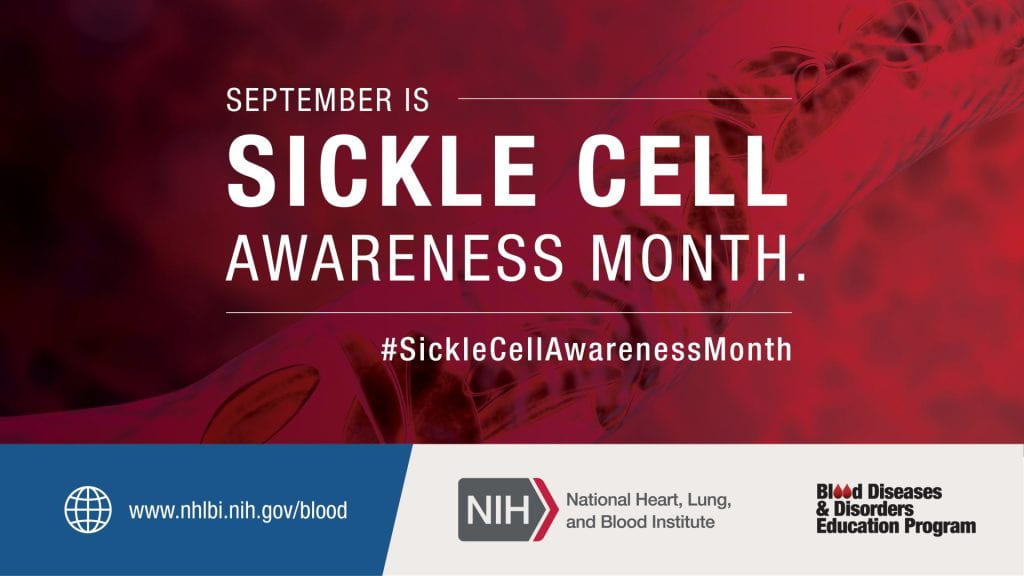
Sickle Cell Disease Awareness Month occurs in September and it is a great opportunity to learn more about this inherited blood disorder that affects approximately 100,000 people in the United States and millions more across the world.
Sickle cell disease is a blood disorder where red blood cells develop a distinct ‘sickle’ shape instead of the normal disc shape. These unusually shaped red blood cells are not flexible, thus making it difficult for the cells to travel through blood vessels. Because of the potential for blood vessels to get clogged, people living with sickle cell disease may experience extreme pain crises, strokes or other severe health complications. Sickle-shaped red blood cells usually last in the body between ten to twenty days and the body cannot quickly add new blood cells to replace the lost cells, thus people with this disorder are also likely to develop anemia.
This disorder can affect anyone, but it is mostly commonly found in people of African descent and within the United States this disorder occurs in approximately one in every 365 African American children. There are also high concentrations of this disorder within Hispanic populations, where it is estimated that one in every 1,000-1,400 Hispanics Americans live with sickle cell disease. (MedlinePlus, 2020)
Testing is available to determine if someone has sickle cell disease or if they carry the trait. If a person has sickle cell disease, there are treatment plans to help manage pain, prevent red blood cells from taking on the sickle shape and prevent blood vessel clogs, but unfortunately the only potentially curative intervention for this disorder is a blood and bone marrow transplant.

Researchers at the National Health, Lung and Blood Institute are actively looking for new treatment options and cures. The Center of Disease Control also has a Sickle Cell Data Collection program that tracks the disease in the country “to study long-term trends in diagnosis, treatment, and healthcare access for people with SCD (sickle cell disease)...The program helps to inform policy and healthcare standards that improve and extend the lives of people with SCD.) (Centers for Disease Control and Prevention, 2021, para. 1) Data from California and Georgia are currently available, while data from other several states will be made available in the future.
If you are interested in spreading awareness about sickle cell disease, the National Heart, Lung, and Blood Institute has created a social media toolkit with infographics, hashtags and sample posts that can be shared online. You can also help by donating blood. The American Red Cross is particularly interested in African American blood donors who can donate their blood to people living with sickle cell disease. Visit the American Red Cross website to find a local blood donation center or blood donation drive. If you’re interested in hearing the personal stories of people living with sickle cell disease, then visit the Stories of Sickle Cell which features stories, videos and a photoblog of life with this blood disorder.
Himmelfarb also has resources to help you better understand this blood disorder. Some titles that may be of interest include:
- Sickle cell disease and hematopoietic stem cells transplantation edited by Emily Meier et al.
- Pathophysiology of blood disorders by Franklin H. Bunn & Jon C. Aster
- Hematology in Practice by Betty Ciesla
If you have specific research questions, librarians are available to assist you and can be contacted through email, instant messaging, phone or by visiting the reference desk.
Sickle cell disease is the most common inherited disorder and impacts the quality of life for millions of people around the world. With current treatment options, people who live with sickle cell disease can manage their symptoms, while researchers continue to learn more about this disorder and search for additional cures.
References:
Centers for Disease Control and Prevention. (Updated: 2021). Sickle Cell Data Collection (SCDC) Program. https://www.cdc.gov/ncbddd/hemoglobinopathies/scdc.html
MedlinePlus. (Updated: 2020). Sickle Cell Disease. https://medlineplus.gov/genetics/condition/sickle-cell-disease/#frequency
National Heart, Lung, and Blood Institute. (Updated: 2022). Sickle Cell Disease. https://www.nhlbi.nih.gov/health/sickle-cell-disease

